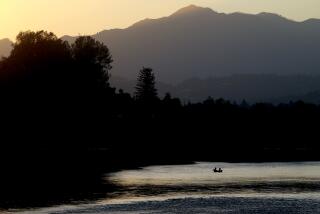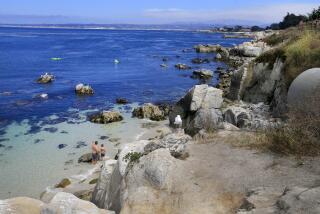Study to test California’s kelp forests for radioactive contamination
The canopies of kelp undulating in the surges off the coast of California camouflage a complex ecosystem of sharks, rock fish, crabs, urchins and anemones that blossom like colorful flowers on the forest floor.
Now, Steven L. Manley, a biology professor at Cal State Long Beach, and Kai Vetter, head of applied nuclear physics at Lawrence Berkeley National Laboratory, have launched a campaign to monitor those groves for radioactive contaminants due to arrive later this year in ocean currents from Japan’s damaged Fukushima nuclear power plant.
“Several features make kelp perfect for a study of this kind,” Manley, a leader of the “Kelp Watch 2014” campaign, said in an interview. “They include kelp’s ability to absorb chemical elements and inorganic ions in seawater and concentrate them in its tissues.”
Of particular interest are two long-lived radioisotopes of cesium released by the power plant after it was devastated by an earthquake and tsunami in March 2011.
“Marine chemists following the damaged plant’s plume across the Pacific Ocean expect very low levels of radioactivity to reach California’s shores,” Manley said. “During the trip, some of these isotopes will be taken up by phytoplankton and enter the oceanic ecosystem.”
“Although kelp is a fairly hardy life form,” Manley added, “it would be interesting to know the contaminants’ effects on creatures that feed on kelp such as fish, which are eaten by sea lions, and urchins, which are eaten by sea otters.”
The initiative will rely on volunteers from 20 academic and government institutions to collect samples of Giant Kelp and Bull Kelp from 33 sites in California, including Long Beach, Malibu and Palos Verdes; two sites in Baja California and one in Washington state.
The sampling is to begin in mid-February and end in late winter.
“We’ll be collecting three 15-pound samples of kelp at each site over the course of the year -- and that’s a lot of kelp!” Manley said. “Each sample will be dried, pulverized to powder and then sent to Vetter at the Lawrence Berkeley National Lab’s Low Background Facility for detailed radionuclide analysis.”
“We have two main objectives,” Vetter said, “to learn more about the distribution and transport of these materials in our world, and to make the results and explanations available to the public.”
Those interested in taking part in the project can contact Manley at Steven.Manley@csulb.edu and should put “Kelp Watch 2014” in the subject line.







